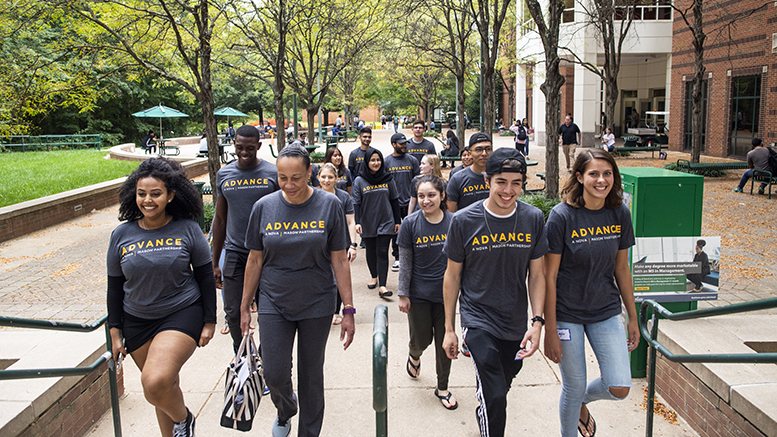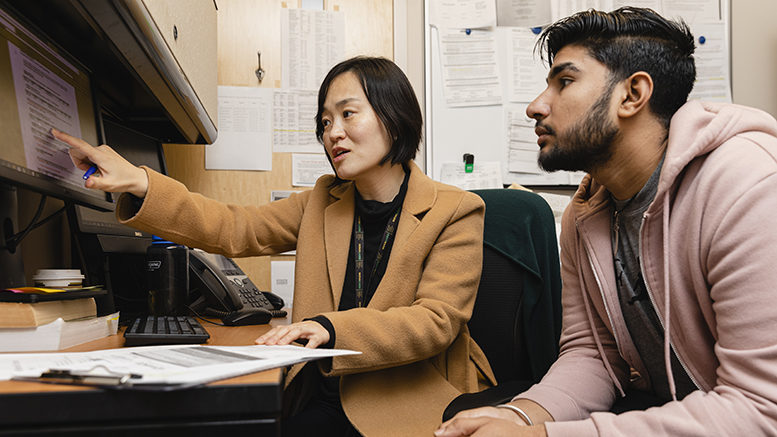As with many community colleges and regional public universities, the path from Northern Virginia Community College (NOVA) to George Mason University in Fairfax, Virginia, has become heavily traveled over the years.
To smooth that path for students, the two schools in 2018 implemented the ADVANCE program, which among other benefits, assigns them one of six “success coaches,” who counsel them throughout their time at both schools and ensure they take the right courses, in the right order and in the most efficient way possible toward completion. The program also provides NOVA students with George Mason health insurance benefits and ID cards so they can use libraries and recreational facilities.
With 1,806 students enrolled as of fall 2020, the program celebrated its first four graduates in December. Of that total enrollment, 48% were first-generation college students, 60% were people of color and 61% were Pell grant eligible. They are able to transfer to Mason with no application fee, provided they have maintained at least a 2.5 grade point average (GPA) at NOVA. The spring 2019 cohort has had an 89% retention rate.
The impetus for the program was that, despite thousands of students transferring every year, NOVA students needed greater clarity to ensure no loss of credit, says Sheri Robertson, interim chief academic officer at NOVA.
“We’re gargantuan colleges,” she says. “Having one person who they can talk to is advantageous, and sort of comforting. The coaches … are helping the students figure out, ‘Alright, it sounds like you’re really not in the right program.’ Or ‘Gee, I see you did really badly this semester, maybe you need to take fewer classes,’ but in a positive light.”
Related article: NOVA and George Mason are among the 16 partnerships selected last week to participate in the Equity Transfer Initiative, which the American Association of Community Colleges will lead with two other higher education organizations.
Coaches are the linchpin, staying on top of shifts in program articulations over time, Robertson says.
“It’s very difficult to figure out not just how does this course transfer, but what courses should students take and in what order,” she says. “And then, as programs change, you have to do it every single year. And we have about 100 different pathways. This is a huge investment of time.”
Regular advisers at NOVA are familiar with the basics of how the program works and help students decide whether they need the extra assistance in the first place, she adds.
Ashlie Prioleau, executive director of ADVANCE, who along with the coaches is jointly employed by the two institutions, says conversations between the schools’ respective presidents led to a joint task force that did research underscoring the opportunities to improve the transfer process — most pointedly, that 80% of community college students said they wanted to achieve a bachelor’s degree, but only 15% were able to do so.
“These two presidents recognized the opportunity to turn around that alarming achievement gap,” she says.
Leadership required
Putting together a program like ADVANCE requires leadership buy-in, Robertson says.
“If you going to do this, you need a commitment from the president of both institutions,” Robertson says. “You need money, so you need your CFO involved. And you need time and patience. We have a draft MOU — which may sound funny because we’ve been doing this for four years now — spelling out in writing what everybody already knows.”
The program requires administrators and faculty from the two schools to routinely compare notes on policies and coursework, Robertson says.
“There’s more to it than figuring out, ‘What should I take if I want to be an English major?’ ” she says. “With policies, we asked ourselves are there ways we could modify ours so the students aren’t feeling like, ‘I did it this way at NOVA, but I’m doing it this way at Mason.’ ”
Prioleau put together the framework and groundwork starting with faculty conversations that ensured academic pathways matched course by course, down to the concentration, “so students do not get lost on their academic journey,” she says. “This is an access-driven program. It’s supposed to open the doors for students to achieve their dream.”
The coaches
The coaches themselves tend to be younger, but the institutions want to make sure they understand the background of typical community college students, Robertson says.
“Let’s say you want to go to the University of Virginia,” she says. “You might not be used to being around people from 129 different countries. A lot of times when people say ‘diverse,’ they’re talking about Black and White, or White and Asian.”
In addition, Robertson notes, some NOVA students have grown up expecting to go to college, while others have had to fight with their parents to matriculate.
“Having coaches who understand that population is super important,” she says. “Around here, people sometimes think a community college isn’t a ‘real’ college. … We have to make sure people don’t look down on us, especially if they’re going to work for us.”

Most coaches have previously worked in the “student success space,” Prioleau says, and one of them has been an assistant admissions director. Typically, community college students preparing to transfer also end up changing advisers, which requires repeating their story and building trust with someone new.
“We wanted to mitigate that,” she says. “We wanted them to have a person from the time they started the program until they graduated George Mason. The difference is that this person will stay with you and can talk to you about any issues.”
That’s especially helpful for first-generation students, who seem to be transferring more easily, Prioleau says.
“Somebody is sitting next to them telling them why you need to submit the FAFSA [Free Application for Federal Student Aid] or where to apply for scholarships,” she says. “They’re getting that handholding. When we think about the diversity needs at Amazon and other companies in the area, they’re looking for more students of color to apply, along with the skill set.”
The challenges
The top challenges involved in setting up a program like ADVANCE include the time spent, keeping up with changes in educational programs, and communicating about it to various audiences, including high school counselors, Robertson says.
“So they understand what ADVANCE is and what it isn’t,” she says. “It does not mean there aren’t other ways to transfer to George Mason.”
Financial aid can be another challenge because it needs to be clearly delineated when a student is at NOVA, and when precisely they enroll at George Mason. And administrators and faculty from both schools needed to figure out parameters like exactly what GPA should be required for students to enroll — and stay — in ADVANCE, Robertson says.
“I had 56 meetings at Mason my first year,” she says. “I actually had a couple of my neighbors ask, ‘Do you work at Mason now?’ because they would see me there. But it was fun because we really got to know one another. That has made all the difference. Now if there’s a potential problem, we can just call each other and talk. Every day, we have some new thing we have to figure out.”
Related article: A better bridge
For schools considering a similar program, Prioleau says it starts with leadership commitment with both the president and vice president, then moves to ensuring that faculty are ready and willing to create seamless pathways and coursework so that students “aren’t wasting time, money and credit to get to the finish line,” she says.
The program provides a career accelerator tool that helps students understand the pathway they will need to take to reach their ultimate goals, Prioleau says.
“What are their interests?” she says. “What skill sets will they need for a particular job? If they want to be a software engineer, students can log in and access that information, which has created more dedication and foresight as to what they’re getting themselves into and how to achieve it.”
And then everyone needs to think innovatively, she adds.
“Myself and the success coaches are co-employed. That is something that blows people’s minds. Which institution owns what? But the reality is, you’re building a bridge, and you’re investing in that bridge.”

